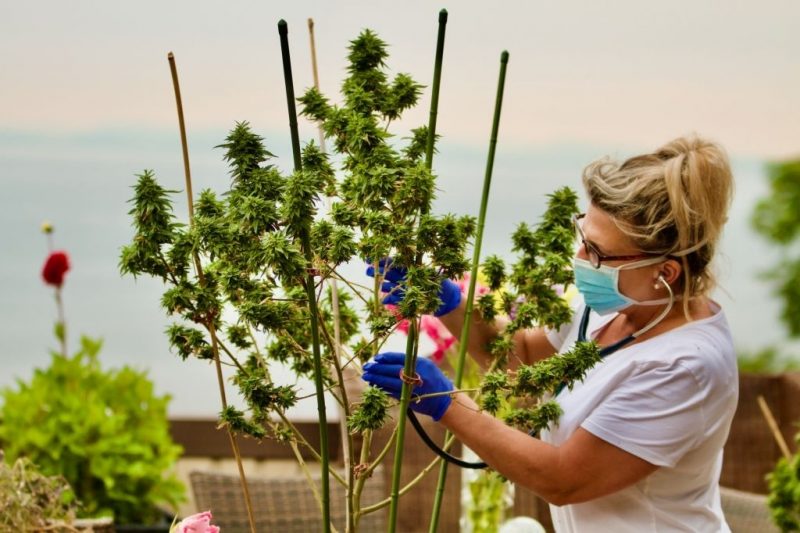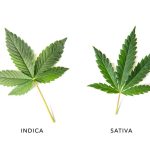🔥 Website for Sale - Contact Us
One of the most effective ways to manage plant size and make the most of confined grow spaces is by controlling the vertical growth of cannabis plants using High Stress Training (HST) techniques.
In this ultimate guide, we will focus on the benefits of limiting cannabis vertical growth, especially for those with restricted grow spaces. We will explore the most popular High Stress Training Techniques, with questions and answers to help you implements these methods like a pro.
II. Benefits of limiting vertical growth in cannabis plants
Controlling vertical growth using High Stress Training techniques offers several advantages, particularly for those working with limited grow spaces.
A. Efficient use of space
By limiting vertical growth, you can cultivate more plants within a confined area, making the most of your available grow space. This approach is especially useful for indoor growers who have height restrictions due to grow room dimensions or those using grow tents.
B. Better light penetration and distribution
When cannabis plants are kept shorter and bushier, light can more effectively reach all parts of the plant, leading to more consistent growth and development. This improved light penetration ensures that lower branches receive enough light, leading to increased bud production and overall yield.
C. Improved airflow and pest prevention
Shorter and well-pruned plants allow for better airflow, which can help prevent mold, mildew, and other fungal infections.
D. Increased yield per square foot
High Stress Training techniques encourage the development of multiple colas or main flowering sites, which can lead to higher yields per square foot.
E. Enhanced plant strength and resilience
High Stress Training techniques, such as topping and super cropping, promote the growth of stronger branches and stems, making the plants more resilient to physical stress and environmental factors. This increased strength can also support heavier bud production.
F. Easier plant management
Shorter and bushier plants are generally easier to manage and maintain, making them ideal for small grow spaces. With limited vertical growth, pruning, watering, and monitoring for pests become more manageable tasks for the grower.
G. Discreet cultivation
For growers who need to maintain a low profile due to legal or privacy concerns, limiting vertical growth can help keep cannabis plants discreet and less noticeable to neighbors or passersby. This is particularly beneficial for those cultivating in urban areas or on balconies.
III. Understanding High Stress Training techniques
A. Topping
Topping is a popular High Stress Training technique that involves cutting the main stem’s growing tip, encouraging the cannabis plant to develop multiple branches instead of a single main stem. This method results in a bushier and more compact plant, ideal for limited grow spaces.
What is topping?
Topping is the process of removing the top growth point of cannabis, which stimulates the growth of multiple new main branches. Here is more about Topping compared to Fimming. This technique redistributes the plant’s energy from the main stem to the newly developing branches, promoting lateral growth and creating a more even canopy.
How to perform topping:
a. Choose the right time: Topping is best performed when your cannabis plant has at least 4-6 nodes (sets of leaves) to ensure it has enough energy to recover from the stress.
b. Identify the growth tip: Locate the top growth point or the apical meristem, which is the area responsible for vertical growth.
c. Sterilize your tools: Use a clean, sharp pair of scissors or pruning shears to prevent infection.
d. Cut the growth tip: Make a clean cut approximately 1/4 inch above the node where you want your plant to branch out. This will stimulate the growth of two new main branches from the node just below the cut.
Advantages and disadvantages of topping:
Advantages:
a. Encourages bushier growth, making it ideal for limited grow spaces.
b. Increases the number of colas, potentially leading to higher yields.
c. Creates a more even canopy, allowing for better light distribution and penetration.
Disadvantages:
a. Causes stress to the plant, which may slow down growth temporarily.
b. Requires careful timing and execution to avoid damaging the plant or causing excessive stress.
c. May not be suitable for all cannabis strains, as some may be more sensitive to topping and may not recover as quickly.
By using the topping technique in your limited grow space, you can effectively control the cannabis plant’s vertical growth and create a more productive and manageable garden.
B. Fimming
Fimming is another High Stress Training technique that, similar to topping, encourages a cannabis plant to develop multiple branches and a bushier growth habit. Fimming stands for “F*** I Missed,” referencing the fact that this method involves cutting the main stem’s growing tip slightly differently than topping.
What is Fimming?
Fimming is a technique where the top growth point of a cannabis plant is partially removed, resulting in the growth of 3-4 new main branches. This method promotes lateral growth and a fuller canopy, making it suitable for limited grow spaces.
How to perform Fimming:
a. Choose the right time: Like topping, Fimming is best performed when your cannabis plant has at least 4-6 nodes (sets of leaves) to ensure it has enough energy to recover from the stress.
b. Identify the growth tip: Locate the top growth point or the apical meristem, which is the area responsible for vertical growth.
c. Sterilize your tools: Use a clean, sharp pair of scissors or pruning shears to prevent infection.
d. Cut the growth tip: Instead of completely removing the top growth point, as in topping, make a cut that removes approximately 80% of the tip, leaving a small portion of the new growth intact.
Advantages and disadvantages of Fimming:
Advantages:
a. Promotes bushier growth, which is ideal for limited grow spaces.
b. Increases the number of colas, potentially resulting in higher yields.
c. Encourages a fuller canopy, allowing for better light distribution and penetration.
Disadvantages:
a. Causes stress to the plant, which may temporarily slow down growth.
b. Requires precision when cutting the growth tip to avoid accidentally topping the plant.
c. Not all cannabis strains may respond well to Fimming, as some may be more sensitive to this technique and take longer to recover.
By incorporating the Fimming technique into your cannabis garden, you can effectively manage your plants’ vertical growth.
C. Super cropping
Super cropping is a High Stress Training technique that involves strategically bending and manipulating the branches of a cannabis plant to control its height and promote bushier growth. This method helps create a more even canopy, which is beneficial for light distribution and penetration in limited grow spaces.
What is super cropping?
Super cropping involves carefully bending and pinching the branches of a cannabis plant, damaging the plant tissue slightly without breaking the branch. This causes the plant to repair the damaged area, creating a knuckle-like growth that makes the branch stronger and more resilient. The process also promotes lateral growth, resulting in a bushier plant with a more even canopy.
How to perform super cropping:
a. Choose the right time: Super cropping is best done during the vegetative stage when the plant’s branches are still flexible and less likely to snap.
b. Identify the branches: Select the branches you want to super crop, focusing on those that are taller or growing faster than the others.
c. Soften the branch: Gently squeeze and massage the branch between your fingers, making it more pliable and less likely to break when bent.
d. Bend the branch: Carefully bend the branch at a 90-degree angle [not breaking]. The goal is to create a slight crease in the branch without completely breaking it.
e. Secure the branch: Use plant ties or soft string to secure the bent branch in place, ensuring it maintains its new position while the plant heals.
Advantages and disadvantages of super cropping:
Advantages:
a. Encourages bushier growth, which is ideal for limited grow spaces.
b. Promotes a more even canopy, allowing for better light distribution and penetration.
c. Strengthens the branches, making them more resilient and capable of supporting heavier buds.
Disadvantages:
a. Causes stress to the plant, which may temporarily slow down growth.
b. Requires careful handling to avoid accidentally breaking the branches.
c. May not be suitable for all cannabis strains, as some may be more sensitive to super cropping and take longer to recover.
By incorporating super cropping into your cannabis cultivation routine, you can effectively manage your plant’s vertical growth.
D. Low Stress Training (LST) vs. High Stress Training (HST)
Both Low Stress Training and High Stress Training techniques are effective in managing the growth and structure of cannabis plants, particularly in limited grow spaces.
Key differences between LST and HST:
a. Stress level: As the names suggest, the primary difference between LST and HST is the level of stress they cause to the plant. LST techniques, such as tying down branches or using a screen (like in the Screen of Green method), apply gentle pressure to alter the plant’s growth pattern with minimal stress. In contrast, HST techniques, like topping, Fimming, and super cropping, involve cutting or bending the plant in ways that cause more significant stress but can lead to more dramatic changes in growth patterns.
b. Recovery time: Due to the higher stress levels caused by HST techniques, plants usually take longer to recover compared to those subjected to LST methods. While LST can be performed consistently throughout the plant’s growth cycle, HST techniques require careful timing and adequate recovery time to avoid stunting the plant’s growth.
c. Suitability for different strains: Some cannabis strains may be more sensitive to stress than others, making them less compatible with HST techniques. LST methods tend to be more universally applicable, whereas HST may need to be adapted or avoided for specific strains.
By understanding the differences between Low Stress Training and High Stress Training techniques, growers can make informed decisions about the best approach to manage the vertical growth of their cannabis plants in limited grow spaces.
IV. A step-by-step guide to implementing High Stress Training techniques
A. Assessing the appropriate stage for HST
Determining the right stage to perform High Stress Training techniques on your cannabis plants is essential for successful implementation and minimizing the risk of damaging or stunting their growth. Here’s how to assess the appropriate stage for HST:
Focus on the vegetative stage: High Stress Training techniques, such as topping, Fimming, and super cropping, are best performed during the vegetative stage of the cannabis plant’s life cycle. During this stage, the plant is focused on growing leaves and branches, making it more resilient to stress and capable of recovering more quickly from HST methods.
Observe the plant’s development: Before implementing any HST technique, closely monitor your plant’s development and growth. Look for the presence of at least 4-6 nodes (sets of leaves) before topping or Fimming, as this indicates that the plant has enough energy to recover from the stress. For super cropping, ensure that the branches are flexible and less likely to snap when bent.
Consider the plant’s overall health: A healthy, robust plant is more likely to recover quickly from HST techniques. Avoid performing HST on plants that appear weak, sickly, or stressed from other factors, such as pests or nutrient deficiencies.
Avoid HST during flowering: Performing High Stress Training techniques during the flowering stage can be detrimental to your plant’s health and yield, as the plant is focusing its energy on developing flowers and buds.
By carefully assessing the appropriate stage for High Stress Training, you can effectively manage your cannabis plant’s growth and development while minimizing the risk of causing undue stress or damage.
B. Choosing the right technique(s) for your cannabis plants
Selecting the most appropriate High Stress Training technique(s) for your cannabis plants depends on various factors, including your strain, growth goals, and experience level. Here are some guidelines to help you choose the right HST method(s) for your plants:
Research your cannabis strain: Different cannabis strains may respond better to certain HST techniques or may be more sensitive to stress. Research your specific strain to understand its growth habits and how it may react to various HST methods. This information will help you tailor your training approach to optimize growth and yield.
Determine your growth goals: Consider your growth goals when selecting HST techniques. If you aim to create a bushier plant with a more even canopy, topping or Fimming might be suitable. For those looking to strengthen branches and further limit vertical growth, super cropping could be the right choice.
Assess your experience level: Some HST techniques, such as topping and Fimming, require more skill and precision than others. If you’re a beginner, consider starting with Low Stress Training methods before attempting HST.
Combine techniques for comprehensive training: Depending on your strain and growth goals, you may benefit from implementing a combination of HST techniques. For example, topping your plants early in the vegetative stage can encourage bushier growth, while super cropping, later on, can help maintain the desired growth pattern and strengthen branches.
By carefully choosing the right High Stress Training technique(s) for your cannabis plants, you can effectively manage their growth, maximize their potential, and make the most of your limited grow space.
C. Following a timeline for HST application
The timeline for applying High Stress Training techniques to during the growth cycle is crucial to minimize potential risks. Here’s how to develop and follow a timeline for HST application:
Map out your plant’s growth stages: Understanding your cannabis plant’s growth stages is essential for determining the best time to apply HST techniques.
Schedule HST techniques based on growth stage: Different HST techniques are best suited for specific growth stages. For example, topping and Fimming should be performed when the plant has at least 4-6 nodes (sets of leaves), whereas super cropping can be done throughout the vegetative stage and early flowering stage. Plan your HST application accordingly to ensure your plants are at the optimal stage for each technique.
Monitor plant health and recovery: After performing an HST technique, closely monitor your plant’s recovery and growth. Ensure it has sufficient time to heal and regain strength before applying additional stress. If your plant shows signs of prolonged stress or fails to recover, adjust your timeline and training approach accordingly.
Allow for flexibility: Your HST timeline should be flexible to accommodate any unexpected changes in your plant’s growth or response to training. Be prepared to adjust your timeline and HST techniques as needed to ensure the best possible outcome for your plants.
Combine HST with other training methods: Consider incorporating Low Stress Training methods into your timeline to complement your HST techniques. For example, you might use a Screen of Green (ScrOG) method in conjunction with topping or Fimming to create a more even canopy and maximize light penetration.
Record your progress: Documenting your HST timeline, techniques, and observations can provide valuable insights into your plant’s growth and response to stress. Keeping track of your progress will help you refine your approach and develop a more effective training strategy for future grows.
By following a well-planned timeline for HST application, you can effectively manage your cannabis plant’s growth, minimize stress, and optimize their performance in limited grow spaces.
V. Tips for successful High Stress Training
Implementing High Stress Training techniques can be a game-changer for managing your cannabis plant’s growth.
Start with a healthy plant: Ensure your cannabis plant is in good health before applying any HST technique. A strong, healthy plant will recover more quickly from the stress of HST, minimizing the risk of stunted growth or other adverse effects.
Sterilize your tools: Always use clean, sharp tools when performing HST techniques that involve cutting or pinching the plant. Sterilize your scissors or pruning shears with rubbing alcohol before and after each use to prevent infections and diseases.
Be patient and gentle: Applying HST techniques requires patience and a gentle touch. Rushing the process or being too forceful can cause unnecessary damage to your plant, resulting in a longer recovery time or even plant death.
Monitor your plant’s response: Keep a close eye on your plant’s recovery and growth after applying HST techniques. Be prepared to adjust your training approach based on your plant’s response, as some plants may require more or less HST intervention than others.
Provide proper care and maintenance: Throughout the HST process, ensure your plants receive adequate water, nutrients, and light. Proper care and maintenance will help your plants recover more quickly from the stress of HST and develop into strong, healthy, and high-yielding specimens.
By following these tips for successful High Stress Training, you can confidently manage your cannabis plants’ growth and make the most of your limited grow space.
VI. Questions and Answers
Q: What are the benefits of limiting vertical growth in cannabis plants using High Stress Training techniques?
A: Limiting vertical growth in cannabis plants using High Stress Training techniques has several benefits, including improved light penetration, better use of limited grow space, more even canopy, increased yield, and stronger branches that can support heavier buds.
Q: How do I choose the best High Stress Training technique for my cannabis plant’s specific needs?
A: To choose the best HST technique for your plant, consider factors such as your cannabis strain, growth goals, and experience level. Research your strain’s characteristics and growth habits, determine your desired growth pattern, and assess your skill level before selecting the most appropriate HST method.
Q: At what stage of the cannabis plant’s growth should I start implementing High Stress Training techniques?
A: High Stress Training techniques should generally be performed during the vegetative stage, when the plant is focused on growing leaves and branches and is more resilient to stress. Techniques like topping and Fimming should be done when the plant has at least 4-6 nodes, while super cropping can be performed throughout the vegetative stage and early flowering stage.
Q: How can I properly care for and maintain my cannabis plants during and after High Stress Training?
A: To care for and maintain your cannabis plants during and after HST, ensure they receive adequate water, nutrients, and light. Monitor their recovery and growth closely, and be prepared to adjust your training approach if needed. Proper care and maintenance will help your plants recover more quickly from HST stress and develop into strong, healthy specimens.
Q: Are there any potential issues or risks associated with using High Stress Training techniques on cannabis plants?
A: Potential issues or risks associated with HST include plant stress, slower growth, and increased risk of injury or infection. However, these risks can be minimized by following a well-planned timeline, using sterilized tools, and closely monitoring your plant’s recovery and growth after each HST application.
Q: Can High Stress Training techniques be adapted for different cannabis strains and growing conditions?
A: Yes, High Stress Training techniques can be adapted for different cannabis strains and growing conditions. By understanding your strain’s characteristics and growth habits, you can tailor your HST approach to suit its specific needs and maximize its potential in your unique growing environment.
VII. Conclusion
High Stress Training is a powerful tool for managing the growth of cannabis plants, particularly in limited grow spaces. By understanding your cannabis strain, selecting the appropriate HST techniques, and following a well-planned timeline for their application, you can effectively limit vertical growth, promote bushier plants, and maximize yields.





